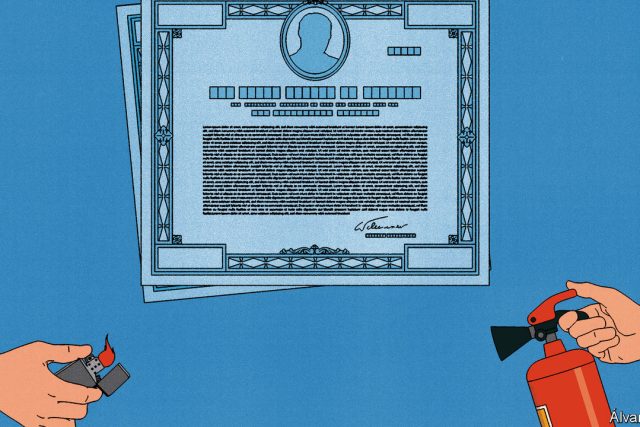Only a few years ago, analysts and investors were aflutter with talk of a new “supercycle” in commodities. Some believed the world was about to repeat a surge in raw-material prices that began in the early 2000s, and lasted until the global financial crisis of 2007-09. This time the prompt was meant to be a mixture of a fast economic recovery, as the West emerged from covid-19 lockdowns, combined with a shift to green energy.
Today the thesis looks far less certain. Prices of lithium and nickel, which are vital for electric-vehicle (EV) batteries, exploded in 2021 and 2022, but have since collapsed. Nickel is almost 50% cheaper than at the start of 2023. Lithium’s fall has been even steeper: its price is down by more than 80% over the same period. The Bloomberg Commodity Index, made up of a basket of foodstuffs, fuels and metals, has declined by 29% since its peak in mid-2022.
Forecasts for oil demand now vary wildly, too, depending on assumptions about governments’ plans to wean consumers off the stuff. The International Energy Agency expects demand for oil to increase to 106m barrels per day (bpd) by 2028, up from 102bpd last year, and global demand to peak not far above that level. The Organisation of the Petroleum Exporting Countries, a cartel of oil producers, expects demand to rise more than twice as fast in the next five years, to 110m bpd, and then to keep rising for at least the next two decades.
Commodity trading has never been simple: prices depend on unpredictable economic cycles, as well as the production capacity of drillers, growers and miners. But it is now nightmarish. On top of such concerns, investors have to contend with a barrage of political and technological uncertainties, which range from developments in battery tech to government appetite for subsidies. And it is these questions that will govern the pace of the green transition.
Start with the EV market. It is clearly still growing: 14m EVs were sold worldwide in 2023, a 35% increase on the previous year. But how fast will it continue to grow? Both new and used EVs are sitting in American dealerships for longer than their petrol-powered rivals. Volkswagen, a German automaker, reports that EVs made up 8-10% of sales in 2023, down from 11% the year before. Ford and GM are among the carmakers to have delayed EV– and battery-plant construction over the past year. Wariness about the sector is dragging on the share price of Tesla, the market leader, which is down by 26% this year. And will evs still need the same battery materials? New sodium-ion batteries require neither nickel nor lithium. If they begin to supersede existing types, demand for the metals will plummet.
Political considerations are also increasingly difficult to track, since the direction of travel is no longer one-way. Politicians across the rich world have started to worry about the costs involved in the energy transition. In September Britain delayed a ban on internal-combustion engines. Ahead of elections to the European Parliament in June, the draft manifesto of the centre-right European People’s Party now opposes an outright ban on such engines. Are these just cosmetic changes or the start of a deeper shift in green policies? Commodity investors need an answer.
Nor is it only Western policies and demand that matter. During the last commodity supercycle, China’s construction of millions of flats, hundreds of thousands of miles of roads and all manner of other physical infrastructure kept demand for hard commodities growing fast. Now demand from the world’s second-largest economy is much less certain. Chinese economic growth has slowed considerably, and investment in property has slumped as the government attempts to steadily deflate a bubble of its own creation. At the same time, copper prices have proved to be astoundingly resilient, dipping just 9% during the past 12 months. This reflects China’s push for self-sufficiency in energy, including in solar and hydro power.
Pity anyone whose job it is to forecast how these factors will play out over the next 12 months: if getting an accurate sense of the trade-offs in Western politics is tough, divining the approach of an increasingly cloistered Chinese government is close to impossible. It is clear that old methods of reading commodity markets are no longer sufficient. Without an understanding of the demand for new vehicles, the technology inside them and the politics of net-zero, any bets on the future of commodity markets will be little more than guesswork. ■
Read more from Buttonwood, our columnist on financial markets:
The dividend is back. Are investors right to be pleased? (Feb 8th)
Bitcoin ETFs are off to a bad start. Will things improve? (Feb 1st)
Investors may be getting the Federal Reserve wrong, again (Jan 24th)
Also: How the Buttonwood column got its name




The Most Read
Сryptocurrencies
Bitcoin and Altcoins Trading Near Make-or-Break Levels
Financial crimes
Thieves targeted crypto execs and threatened their families in wide-ranging scheme
Financial crimes
Visa Warning: Hackers Ramp Up Card Stealing Attacks At Gas Stations
News
Capitalism is having an identity crisis – but it is still the best system
Uncategorized
The 73-year-old Vietnamese refugee is responsible for bringing Sriracha to American consumers
Uncategorized
Electric Truckmaker Rivian, Backed By Amazon, Ford, Raises Whopping $1.3 Billion